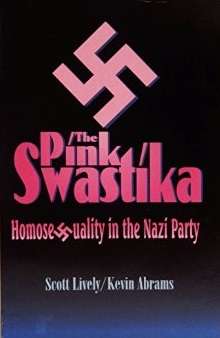The Pink Swastika
 Cover of the first edition | |
| Authors |
Scott Lively Kevin Abrams |
|---|---|
| Language | English |
| Subject | Nazi Germany |
| Published | 1995 |
| Media type | Print (paperback) |
| ISBN | 978-0-9647609-0-5 |
| LC Class | DD256.5 .L55 |
The Pink Swastika: Homosexuality in the Nazi Party is a book first published in 1995 by Scott Lively and Kevin Abrams,[1] and currently in its 5th edition.[2] The book, in which the authors argue that homosexuality in the Nazi Party contributed to the extreme militarism of Nazi Germany, has been widely debunked[3] and drawn extensive criticism from historians.
Summary
According to the authors, homosexuality found in the Nazi Party contributed to the extreme militarism of Nazi Germany. The title of the book, as well as the book itself, is a reference to The Pink Triangle: The Nazi War Against Homosexuals, a book in which Richard Plant details homophobia in the Nazi Party and the homosexual victims of Nazism. Lively and Abrams also take up the subject of Nazism in America and discuss the Boy Scouts. They state that many leaders in the German Nazi regime, including Adolf Hitler himself, were homosexual and says that eight of the top ten serial killers in the US were homosexuals.[4][5] They claim that persecution of homosexuals was only directed towards feminine homosexuals.[6] One significant source for The Pink Swastika was Samuel Igra's Germany's National Vice, which Lively refers to as "the 1945 version of The Pink Swastika."[7]
Reception
Erik N. Jensen regards the authors' linkage of homosexuality and Nazism as the recurrence of a "pernicious myth", originating in 1930s attacks on Nazism by Socialists and Communists and "long since dispelled" by "serious scholarship".[8] Jensen sees the book as coming about in "the aftermath of an Oregon measure to repeal gay rights".[8] Dorthe Seifert cites it as a response to increasing awareness of Nazi persecution of homosexuals.[9] Christine L. Mueller argues that the historical record does not support Abrams' assertions.[10] Bob Moser, writing for the Southern Poverty Law Center, says the book was promoted by anti-gay groups and that historians agree its premise is "utterly false".[11]
Jonathan Zimmerman, a historian at New York University, wrote that the claim that gay people helped bring Nazism to Germany "is a flat-out lie."[12] Zimmerman, points out that "Between 1933 and 1945, the Nazis arrested roughly 100,000 men as homosexuals. Most convicted gays were sent to prison; between 5,000 and 15,000 were interned in concentration camps, where they wore pink triangles to signify their supposed crime."[12] He further notes, "To win their release from the camps, some gays were forced to undergo castration. Others were mutilated or murdered in so-called medical experiments by Nazi doctors, who insisted that homosexuality was a disease that could be 'cured'."[12] In addition, "Hitler authorized an edict in 1941 prescribing the death penalty [...] for SS and police members found guilty of gay activity."[12][13]
References
- ↑ Lively, Scott; Abrams, Kevin (1995). The Pink Swastika: Homosexuality in the Nazi Party. Founders Publishing. Corporation. ISBN 978-0-9647609-0-5.
- ↑ "The Pink Swastika". Retrieved 2014-11-08.
- ↑ 11 Things to Know about Scott Lively, the Anti-Gay Pastor Challenging Charlie Baker. Spencer Buell, Boston, 30 April 2018
- ↑ "People & Events". Mennonite Brethren Herald. 1999-11-05. Archived from the original on 2007-05-25. Retrieved 2007-06-14.
In their controversial book, The Pink Swastika, Scott Lively and Kevin Abrams assert that many leading members of the Nazi Party in Germany were homosexuals. They also state that eight of the top ten serial killers in the United States were homosexuals, including Donald Garvey, John Wayne Gacy, Patrick Wayne Kearney, Bruce Davis and Jeffrey Dahmer. The Apr. 22 The Globe and Mail reported that the Columbine high school killers 'professed to be bisexuals'. – RTV Bulletin, Western Report
External link in|publisher=(help) - ↑ "Religious Right Groups Involved in Antigay Incidents". People For the American Way. Archived from the original on 2006-12-15. Retrieved 2007-06-14.
the controversial book, The Pink Swastika,
- ↑ Lively, Scott; Abrams, Kevin. "The Pink Swastika" (PDF). p. 23. Archived from the original (PDF) on May 6, 2014. Retrieved August 7, 2014.
As war became more important to the Germans, the male warriors and their culture became dominant, and the status of women declined. Effeminacy and receptive homosexuality were increasingly scorned and repressed....The effeminate homosexual...was depicted as a foul monster....this stigmatization did not extend to active male homosexuality. [Later, acceptability of masculine oriented homosexuality declined under Christianity, which] was officially opposed to all forms of homosexuality (Greenberg:249f)"
- ↑ Lively, Scott. Scott Lively speaks about his book, The Pink Swastika. Event occurs at 26'15. Archived from the original on 2015-04-12.
- 1 2 Erik N. Jensen (January–April 2002). "The Pink Triangle and Political Consciousness: Gays, Lesbians, and the Memory of Nazi Persecution". Journal of the History of Sexuality. 11 (1/2): 319&ndash, 349, pp. 322&ndash, 323 and n. 19. doi:10.1353/sex.2002.0008.
- ↑ Dorthe Seifert (Fall 2003). "Between Silence and License: The Representation of the National Socialist Persecution of Homosexuality in Anglo-American Fiction and Film". History and Memory. 15 (2): 94&ndash, 129, p. 94. doi:10.2979/HIS.2003.15.2.94.
- ↑ "The Other Side of the Pink Triangle: Still a Pink Triangle". October 24, 1994. Retrieved 2008-11-08.
- ↑ Bob Moser (Spring 2005). "Making Myths". Intelligence Report. Southern Poverty Law Center (117).
- 1 2 3 4 Zimmerman, Jonathan (August 27, 2011). "Did Nazis persecute gays, or were they gay themselves?". The Bakersfield Californian/History News Service.
- ↑ Herzog, ed. by Dagmar (2005). Sexuality and German fascism. New York: Berghahn Books. p. 265. ISBN 9781571815514. Retrieved 22 April 2015.
See also
External links
- The Strange, Strange Story of Gay Fascists. Johann Hari. Huffington Post (October 21, 2008)
- The Pink Swastika 5th (Internet) edition
- The Pink Swastika 4th edition
- The Pink Swastika 3rd edition
- The Annotated Pink Swastika, a fact check of the authors' sources, and corrects the more serious factual errors contained in the book.